Mark Sisson's Blog, page 155
February 1, 2018
14 Ways To Hack an Ice Cube Tray
 After so many great questions and suggestions on the comment board this month, we’ve got kitchen efficiency on our minds. Keeping a healthy Primal Kitchen running smoothly and economically isn’t hard, but some creative strategy sure makes it easier.
After so many great questions and suggestions on the comment board this month, we’ve got kitchen efficiency on our minds. Keeping a healthy Primal Kitchen running smoothly and economically isn’t hard, but some creative strategy sure makes it easier.
If you’re only freezing water in your ice cube tray, you’re missing out. Everything from herbs, to dark chocolate, to bacon fat and even wine can be frozen into flavor cubes that will change the way you cook. It’s all about more flavor, more convenience, and less waste.
Simply pour ingredients into an ice cube tray, and freeze. Once frozen, all of these flavor cubes can be stored in freezer bags for up to 3 months. Use the ice cube tray already in your freezer, or look online for new trays in a variety of sizes and shapes.
Herbs and Oil
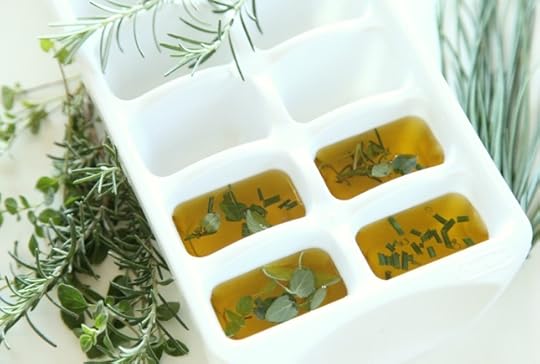
Use up fresh herbs instead of watching them wilt by combining extra virgin olive oil or avocado oil with freshly plucked herbs. Melt frozen oil & herb cubes in a saucepan before sautéing meat or vegetables for instant herbal flavor.
Pesto
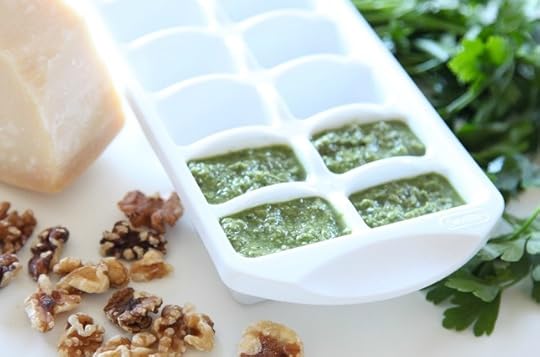
Another way to freeze fresh herbs is by freezing pesto into cubes. This is a great way to preserve a bounty of fresh basil in the summer, or other types of pesto like parsley and cilantro. Instead of cooling soup with a watery ice cube, put a frozen pesto cube in your soup bowl instead.
Animal Fat

An easy and space-efficient way to store bacon grease (or chicken fat, or tallow) is by pouring warm, liquid fat into an ice cube tray. Store the cubes of animal fat in a freezer bag and pull one out whenever you sauté something.
Ginger and Garlic
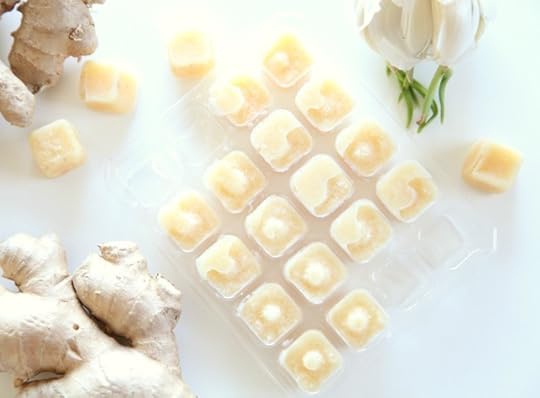
Having pureed ginger and garlic at your fingertips saves a lot of precious time when you’re trying to get dinner on the table. To make, simply puree peeled, sliced ginger or whole peeled garlic cubes with water until smooth, then freeze. Pop a frozen cube of garlic directly into a sauté pan with oil for you next stir-fry recipe, or use the cubes for marinades and sauces. Tip: Use a smaller ice cube tray, since most recipes only require a little bit of garlic or ginger.
Wine
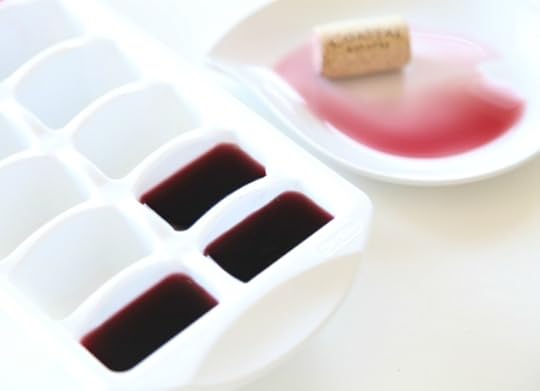
Don’t want to open a bottle wine just to deglaze a pan? That’s where wine cubes come in handy. Frozen cubes of red or white wine can be melted in a pan with butter, or added to tomato sauce or stew. For a refreshing, low-alcohol drink, pour sparkling water over a wine cube.
Frozen Greens

Puree fresh greens (like baby spinach) with a little water to make a green slurry, then freeze into cubes that easily add extra nutrients to soups, stews, chili, smoothies and other dishes.
Fruit Puree

Puree and freeze fresh fruit (think mango or berries) and use the cubes as fruit bombs for smoothies, miniature popsicles (put a toothpick in the ice cube while it freezes), or as a colorful way to flavor sparkling water.
Chocolate
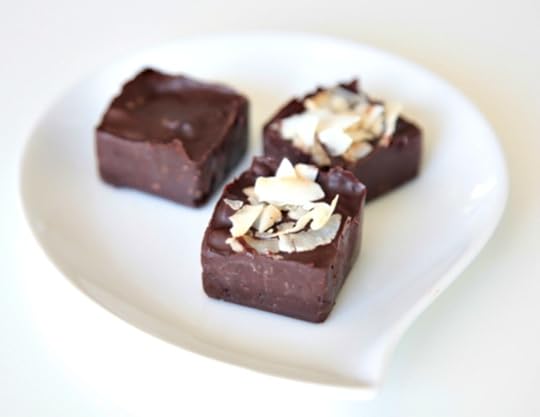
Use a silicon ice cube tray to freeze melted dark chocolate into tiny bars or festive shapes (like hearts). Add chopped nuts, coconut, or your favorite super-food for a healthful treat.
Coffee

Never suffer through a watery glass of iced coffee again when you have coffee ice cubes on hand. These caffeine-packed cubes can also be added to smoothies.
Additional Ideas
And that’s not all… Try these ideas, too, for ingredients you use on occasion or want handy in smaller portions at a moment’s notice:
Buttermilk
Tomato Paste
Chicken Stock
Bone Broth
Pureed Avocado
Remember, you’re limited only by your Primal-minded creativity (and how much room there is in the freezer).
Thanks for reading today, everyone. We’d love to hear how you make multiple use of your ice cube trays.

The post 14 Ways To Hack an Ice Cube Tray appeared first on Mark's Daily Apple.



Primal Challenge Point: Stop Feeding the Sugar Cycle
 It’s impossible to talk about using food as a drug without looking at the genuine neurological and hormonal impacts it has on the body. The fact is, certain foods affect us more like drugs than others.
It’s impossible to talk about using food as a drug without looking at the genuine neurological and hormonal impacts it has on the body. The fact is, certain foods affect us more like drugs than others.
With actual drug use, we’re not operating with innate satiation signaling. But with food, our bodies have a built-in system for telling us when to eat, how much to eat and when to stop.
In our paleolithic ancestors’ time, it worked great. Today, we’ve become our own saboteurs. We’ve known for years that sugary and processed foods (those that strategically combine sugar, salt and certain fats into a triple crown disaster) are intentionally designed to override our inherent satiation signals and hyper-trip our reward systems.
Unfortunately, our own body composition can work against us—leading us deeper into a cul-de-sac of poor eating choices and behaviors. Leptin is one key hormonal player in our satiety signaling. When we’re obese, we lose leptin sensitivity, and we’re drawn to eat despite being functionally full. This is where we get into trouble and the gate is open to food dependence—a phenomenon that looks strikingly similar to chemical drug dependence in neurological scans.
The physiology here could easily be its own post, and I’ve written about these issues in the past. Suffice it here to say that it’s time to kick sugar/high carb (same deal) and processed foods to the curb. You’ll be forever waging an uphill battle with these food products. Food chemists have you by the tail. Get the monkey off your back by going cold turkey or by gradually replacing these choices with healthier ones that won’t hijack your physiology.
— From “How To Stop Using Food Like a Drug”
Want to make fat loss easier?
Try the Definitive Guide for Troubleshooting Weight Loss for free here.
The post Primal Challenge Point: Stop Feeding the Sugar Cycle appeared first on Mark's Daily Apple.



January 31, 2018
5 Suggestions for Becoming Less Civilized (and a Giveaway)
 Civilization has given us great gifts. Infectious diseases rarely kill us anymore. We have hot running water that’s safe to drink (usually). We can go down to the market and buy a thousand different foods. Things are, for the most part, safe and comfortable. Of course, many of the benefits of civilization have been solutions to problems it introduced. That we rarely die from infectious disease is significant because the high population densities of early civilizations created such high infectious disease burdens; nomadic hunter gatherers didn’t have that issue. But there are benefits.
Civilization has given us great gifts. Infectious diseases rarely kill us anymore. We have hot running water that’s safe to drink (usually). We can go down to the market and buy a thousand different foods. Things are, for the most part, safe and comfortable. Of course, many of the benefits of civilization have been solutions to problems it introduced. That we rarely die from infectious disease is significant because the high population densities of early civilizations created such high infectious disease burdens; nomadic hunter gatherers didn’t have that issue. But there are benefits.
Civilization has also harmed us. There’s the usual laundry list of maladies, like industrialized diets, sedentary lifestyles, dysfunctional circadian rhythms, skyrocketing rates of obesity, diabetes, and cancer that we discuss on here all the time.
But there’s also our wildness. For a civil society to function, it must tamp down excessive wildness among its citizenry. Someone’s got to maintain the roads, fix the plumbing, drive the buses, and get up and go to work on time. Yet, the call of the wild persists….
Humans have always represented the intersection of wildness and order. We have animal urges and instincts, and we have reason and logic. We’re subject to the natural world, and we mold and shape it. We’re civil, but with an edge. It’s that precarious balance between chaos and order that helps us do incredible things. The crazy vision of stepping foot on the moon and the discipline necessary to get us there safely. When we become “too civilized,” we lose that edge. On the balance, I’ll take the civilization, but we can do it better by reintroducing wildness into our personal lives.
“Wild” isn’t “crazy” or “savage” or “violent.” It can include ebullience, but it’s mostly about loosening the shackles of what civilization expects you to be and do.
Besides the obvious and dependable ways to become less civilized, like taking wilderness skill classes, flouting conventional dietary wisdom, camping, and hiking, what are some other suggestions?
Adjust Your “Create:Consume” Ratio
To consume is to be passive, comfortable, civilized. Civilization needs consumption. It’s necessary. But civilization and the humans who populate it also need creation, and that’s a bit more wild. It’s pushing the boundary, riding the edge. This isn’t an either-or situation. Everyone consumes. Everyone should create, too. How’s your ratio?
You don’t have to start a blog or write books. You don’t have to become an oil painter or sculptor. Although those are all great options for cultivating wildness via tweaking the create:consume ratio, they’re not the only way.
Creation can be almost anything as long as it introduces something new to the world. It can be minor or monumental. If you’re reading a blog and a thought comes to you, write a comment. If you’re scrolling through a Twitter conversation and have something to contribute, do so. Participate. You could be dungeon master for a Dungeons and Dragons group—that’s creating a narrative for others to inhabit. You could convince your buddies to start training with you—that’s creating good, healthy habits in people who didn’t have them. Direct your energy outward, rather than be a passive recipient of exogenous energy.
Learn a Martial Art
There’s a real human predilection toward violence that, if ignored or repressed, often explodes into tragedy. Martial arts can be a good outlet for that. Now, I don’t know this first-hand. As a kid, I got into my fair share of mostly-friendly scrapes and rough and tumble play, and it was great. Every kid should do that (few do these days). But I don’t have any real experience with martial arts. Not learning one is actually one of my major regrets in life. In recent months, however, I have done some very easy grappling drills with an acquaintance who’s been training for most of his life. It’s been awesome. Nothing too serious or intense. But I get a real sense of how I’d respond in a violent situation.
Don’t do what I did. Learn a martial art. There’s an element of wildness—you’re learning how to do and avoid violence, how to face another human being in simulated mortal conditions—tempered with control and the boundaries of civilization—no one’s going to die or get seriously hurt. From my limited experience, I’d say try a grappling art like Brazilian jiu-jitsu or wrestling.
Indulge Your Fandom
Humans have a sense of tribalism encoded in us, a desire for allegiance toward and acceptance from a group. For some, that manifests as ethnic or religious hatred. There are obvious problems with those manifestations. Could there be a positive outlet for our tribalism? Research shows that diehard sports fans see physiological benefits when their teams compete, such as boosts to testosterone and increased empathy. Sports fans even have a higher-than-average sense of meaning in their lives, something many modern humans lack.
I’m guessing this may apply to more “nerdy” allegiances, like Star Wars vs Star Trek, Marvel vs DC, or Playstation vs XBox, though I have to draw the line at adult My Little Pony fans. Sorry.
It goes without saying that you shouldn’t let these tribal allegiances consume your life. Don’t spend every waking moment following sports, politics, or pop culture. That’d be like engaging in perpetual warfare with a rival tribe—no good.
In fact, I think some of these “open-ended” tribal conflicts are the most dangerous. In sports, as on the battlefield, there’s a definitive, objective conclusion to the conflict: Your team either wins or loses. Everyone accepts the outcome, because the outcome is undeniable. In politics or pop culture, the battle never ends. It drags on, and drags you down with it.
Get Your House In Order
When chaos envelopes us at home—dirty dishes in the kitchen, clothes strewn around, papers everywhere, bills unpaid, responsibilities mounting—we devote most of our creative energy to blocking it out, to ignoring it, leaving us little energy left over to embody our true, wilder selves. Don’t do this.
Instead, deal with the issues directly. Clean the place up. Address all the energy suckers. You’ll probably find that most of them resolve rather quickly, and you have far more time and energy left over to create, learn, play, and indulge the call of the wild.
And, yes, I think there’s an argument to made for minimalism here.
Interact With the Environment In Atypical Ways
Civilization has created neat, linear environments with walkways and paths and boundaries. Normally, we stay between the lines, stay off the grass, and generally follow the rules. Try not doing that.
Climb trees, randomly. Do so in full view of others; it may inspire them to do something similar.
Walk or bear crawl along the backs of park benches. Be cautious about it.
Take shortcuts. Vault over fences.
Sprint up stairs.
Do pullups at crosswalk light posts, overhead branches, ledges, anything that you can grip and hang from.
Be a weirdo, not a jerk. You shouldn’t walk through wilderness protection zones or trample someone’s garden. Don’t trespass.
I’m curious how you foster de-civilization in your life? Any comments, reactions, responses? I’d especially love to hear about martial arts more experienced folks can recommend.
Now For the Giveaway…
As we wrap up this kickoff month of 2018, the question becomes: how do you take your intention to the next level? Today I offered up some ideas for those often neglected but still essential “other” foundations of a healthy and fulfilling Primal life.
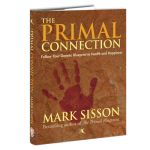 And I want to offer one random commenter on today’s post something to help in that regard—a copy of The Primal Connection and a $50 gift certificate to PrimalBlueprint.com to apply to other books (or anything on the site) that might support his/her next steps.
And I want to offer one random commenter on today’s post something to help in that regard—a copy of The Primal Connection and a $50 gift certificate to PrimalBlueprint.com to apply to other books (or anything on the site) that might support his/her next steps.
Just tell me some thought inspired by today’s post—or something you’d like to see me cover about these “extra” essentials of Primal living: play, sun, sleep, nature, barefooting, etc.
Be sure to comment on today’s post by midnight tonight (1/31/18 PST) to be eligible.
Take care, everyone. Be well!
Want to make fat loss easier?
Try the Definitive Guide for Troubleshooting Weight Loss for free here.
The post 5 Suggestions for Becoming Less Civilized (and a Giveaway) appeared first on Mark's Daily Apple.



Primal Cooking Point: Italian Dressing, Anyone?
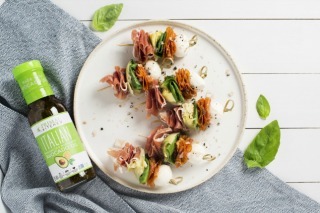 Everyone here knows how much I love my Big Ass Salads. So, the day we come out with a new dressing is a very good day in my mind. And this one might just be my new favorite…. I’m happy to introduce the new PRIMAL KITCHEN® Italian, and I think you’re going to love it.
Everyone here knows how much I love my Big Ass Salads. So, the day we come out with a new dressing is a very good day in my mind. And this one might just be my new favorite…. I’m happy to introduce the new PRIMAL KITCHEN® Italian, and I think you’re going to love it.
It’s a light, perfectly seasoned dressing, dip and marinade for all of your Mediterranean inspired dishes that’s filled with organic ingredients including thyme, oregano, red wine vinegar, lemon juice and sea salt. High in healthy monounsaturated fats, it’s Keto, Whole30 and Paleo/Primal Approved as well as Non-GMO Project Verified.
And let me share one of the ways I’m enjoying our new Italian: Antipasto Skewers. There’s no exact science to follow here—just your own Antipasto favorites like nitrate-free shaved meats, mozzarella, basil leaves, and artichoke folded together and dipped (or doused, if you’re me) in PRIMAL KITCHEN Italian Dressing.
I know what I’m having for lunch. Thanks for reading this morning, everyone. I’ve got a post—and a giveaway—coming up, so be sure to stop back.

The post Primal Cooking Point: Italian Dressing, Anyone? appeared first on Mark's Daily Apple.



January 30, 2018
Primal Kitchen Efficiency: 13 Tips for Daily Organization and Smooth Cooking
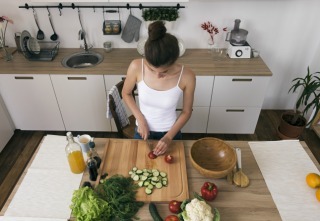 Good cooking is art and science. You’re measuring, you’re tasting, you’re following recipes, you’re following intuition. You’re adding a dash of this, a level teaspoon of that. It’s clinical and sensual at once. For this kind of good cooking to occur, pleasurable cooking, the kitchen needs to disappear. It must get out of the way and become an extension of your body. You shouldn’t have to think about what to use or where to grab it; you just know it. A messy, disjointed lab or workspace is hell.
Good cooking is art and science. You’re measuring, you’re tasting, you’re following recipes, you’re following intuition. You’re adding a dash of this, a level teaspoon of that. It’s clinical and sensual at once. For this kind of good cooking to occur, pleasurable cooking, the kitchen needs to disappear. It must get out of the way and become an extension of your body. You shouldn’t have to think about what to use or where to grab it; you just know it. A messy, disjointed lab or workspace is hell.
The ideal kitchen is just that, of course, an ideal. It’s probably not attainable or maintainable. Something will always come up to mar the optimality, like a toddler hanging on your ankle or the dirty dishes from last night or that damn spatula that always blocks the drawer from opening. But we can aim for it and get as close as possible.
These tips aren’t specific to Primal. They’re not specific at all; I won’t tell you which dishes to make. They are general guidelines that will increase the efficiency of any home cook.
First, Remove Clutter
Clutter gets in the way. The more stuff you have in your kitchen, the more likely something is going to end up on your counters when you’re trying to set up your mise en place, slow you down when grabbing that pot you need.
For Cookware, Quality Over Quantity
We’ve all stayed at that vacation rental whose description promises a “fully stocked kitchen” only to have cupboards and drawers stuffed with dozens of scratched teflon pans, aluminum skillets, rusty cast iron, and cheap stainless steel. Technically the description was accurate, but at what cost? You’re banging and clattering around just to get at the good stuff.
You want the cooking session to go smoothly, elegantly, with grace? Keep only high-quality cookware, and less of it, and you’ll glide through the kitchen. Buy fewer items of higher quality.
Stainless steel, not aluminum.
Cast iron and carbon steel, not nonstick.
Use Multi-Use Tools Whenever Possible
Single-use kitchen tools are fun to use when you need one—and that’s it. Otherwise, they collect dust and get in the way. How often do you need a garlic press? Do you really need that avocado slicer? Or that apple peeler—really?
Obviously, if you use the tool all the time, keep it around. If you’re running a crepery out of your kitchen, keep the crepe pan. But if you only bust out the single use contraption once or twice a year, give it up.
An Instant Pot is the perfect example of a complex kitchen tool that replaces many: your slow cooker, rice cooker, yogurt maker, and stove top pressure cooker. A sharp chef’s knife is the perfect example of a simple kitchen tool that replaces many complex single-use tools.
Get Nesting Storage Containers
Glass storage containers are really hit or miss. They’re inert, thus far better than plastic, but too many of them stack rather than nest, creating precarious piles of glassware. They take up too much room in the drawers, they’re liable to fall over and break, and they always end up messy and disorganized.
When you nest, you save space, and your containers are more secure.
I like these nesting glass containers from Rubbermaid.
Throw Out Old Spices
Once exposed to air, spices degrade quickly. Go through your spice drawer/bin/shelf and inspect each spice with a sniff. If it has no discernible aroma, toss it. If there are duplicates, keep the one that’s fresher. There’s nothing more annoying than taking an extra ten minutes to scour your cluttered spice drawer for the last ingredient.
When you’re cooking, or getting ready to cook, keep these tips in mind.
Clean As You Go
If you’ve ever faced the chaos of a post-dinner party kitchen, you know the value of cleaning up as you cook. It takes a little more effort at first, but it makes the cooking experience flow more smoothly, and it reduces chaos and clutter. Few people manage to religiously adhere to this one. That’s okay. You don’t have to clean everything as you go. Cleaning even just a few items as you cook will lighten the load you face at the end and reduce clutter in your workspace. Everything helps.
Have A “Peel Bowl”
When you’re cutting onions, peeling shallots, smashing garlic, or doing any kind of vegetable prep, you end up with a ton of sticky waste material that gets everywhere and mixes in with the veggies you’re keeping. Keep a large bowl next to the work area for direct deposits of vegetable cuttings. Instead of accumulating on the cutting board, they go right into the bowl. If you compost, you could just have a small compost bin nearby to chuck everything directly in.
Keep Your Salt In a Wide-Mouthed Glass
I keep kosher salt in an open wide-mouthed glass about 2.5 inches in diameter. This allows me to grab pinches whenever I need it, and it gives me perfect control over the amount of salt I wish to apply. If I’m cooking something involved, I’ll usually use a separate glass with all the salt I’ll need for that cooking session. I can dip into the salt without washing my hands in between applications, because I’ll just wash the glass at the end.
Have Very Hot Water on Hand
Hot water can very quickly come to a boil. Eminently useful for cooking for obvious reasons.
Hot water can be used to clean dishes. Better to use a little near-boiling water than let your sink run.
You can bring a pot to boil, then cover it. It’ll stay warm for a long time. You can also keep water warm in your Instant Pot using the “warm” setting, which hits about 160°F.
Immediately Soak or Wipe Gelatinous Saucy Dishes
I love a good reduction using bone broth or added gelatin. You reduce until the collagenous viscosity coats the spoon. It’s the secret of many restaurant sauces—high quality bone broth reduced to a syrup.
However, if you leave that pan or those dishes for more than a few minutes without cleaning them, exposure to cooler air quickly hardens the sauce and makes cleaning it extremely difficult. Wipe those dishes clean right away, perhaps with your tongue.
For general kitchen efficiency, keep these tips in mind.
Keep an Overabundance Of Dish Towels
You can never have too many dish towels. They’re less wasteful than going through half a roll of paper towels, they seem to “mop up” spills and sticky fingers better than anything else, and they can double as pot holders. Get the cheapest ones you can find that still absorb liquids; nothing worse than those towels that just push the spill around.
Come Up With Some “Kitchen Rules,” and Stick To Them
One of mine is “keep the counters cleared at the end of the day.” This gives me a clean, fresh start every morning. I may not eat breakfast very often, but I don’t like coming out to a dirty, cluttered counter in the morning.
Another is “clean the coffee maker right away.” This also gives me a better start in the morning. My day goes much more smoothly when I can start out with a clean French press that’s ready to accept coffee and water. Cleaning it right away also means the grounds come out more easily. They have less time to adhere to the walls.
Purge Your Fridge Every Week and Your Pantry Every Month
You shouldn’t be embarrassed for guests to open your fridge. Check the back for old leftovers. Dig through the cheese drawer for mold that’s not supposed to be there. Discard slimy greens. A clean, organized fridge is a pleasure to encounter and will make cooking that much easier.
Same goes for your pantry. Pantry items won’t go bad so easily, but it’s really easy to just keep stacking stuff on top of stuff until you can’t find anything and the pantry door won’t even close.
Just be an adult about the state of your fridge and pantry. You know when it’s getting out of hand. Don’t ignore it.
That’s what I’ve got, folks. It keeps my kitchen running pretty smoothly. What about you? I’d love to hear tips and tricks from my intrepid readers, and so would my readers.
Thanks for reading, everyone. Don’t miss the final New Year giveaway with tomorrow’s feature. Take care.
The post Primal Kitchen Efficiency: 13 Tips for Daily Organization and Smooth Cooking appeared first on Mark's Daily Apple.



Primal Knowledge Point: FODMAP
 “Some people continue to suffer uncomfortable digestive problems despite omitting the foods they may be intolerant to. If there are no definite test results pointing at an allergy or intolerance, then you’ll most likely be diagnosed with irritable bowel syndrome (IBS).
“Some people continue to suffer uncomfortable digestive problems despite omitting the foods they may be intolerant to. If there are no definite test results pointing at an allergy or intolerance, then you’ll most likely be diagnosed with irritable bowel syndrome (IBS).
Scientists Peter Gibson and Susan Shepherd at Moash University in Australia researched the reasons behind the vicious cycle of bloating, diarrhea, constipation, and discomfort. They came upon some evidence proving that certain sugars could actually be the cause of many of these ailments: ‘Fermentable Oligo-Di-Monosaccharides and Polyols,’ thus founding the term FODMAP.
Fermentable: these types of sugar have the ability and tendency to ferment in our intestines, resulting in bloating and diarrhea.
Oligosaccharides: fructans (FOS), wheat, rye, onions, garlic, galactans (GOS) (legumes), chickpeas.
Disaccharide: sucrose, maltose, lactose.
Monosaccharide: fructose, glucose, and galactose.
Polyol: sorbitol, mannitol, xylitol, maltitol (sugar substitutes).
It is not possible to completely avoid each and everyone one of these types of sugar, since they are found naturally in the food we eat. It would be wise to avoid eating foods containing large amounts of these sugars for a certain amount of time, simply to see if they could be the reasons behind the problems you may be experiencing.
Research has proven that there is a certain daily limit of FODMAPs that can be tolerated. If you’ve eaten your daily limit in lactose already, then it’s no wonder that when you eat the same berries that you ate the day before with no negative effects, all of a sudden they cause you discomfort. Try picturing your FODMAP limit, applying it throughout the day, distributed evenly in each meal. If you go over your limit, then you are bound to have negative reactions.
The pure food Paleo diet eliminates the consumption of fructose and galctan by eliminating grains. Legumes are also avoided with the occasional exception. You are able to test fruits after a grace period, using the guide to see which fruits are better tolerated than others. It all depends on moderation.”
—From Fruit Belly: A 4-Day Quick Fix To Relieve Bloating Caused by High Carb, High Fruit Diets by Romy Dollé
The post Primal Knowledge Point: FODMAP appeared first on Mark's Daily Apple.



January 29, 2018
Dear Mark: Better Rest, and a Parent’s Nightmare: Tablets and Pickiness
 For today’s edition of Dear Mark, I’m answering two questions from readers. First, does “better rest” exist? I think it does, and I give the two “types” of rest I find to be the most effective. Second, a parent writes in with two common issues—pickiness at the dinner table and an obsession with tablets. What can a parent do to deal with a kid who only wants pasta and rice? And how to handle tablet obsession?
For today’s edition of Dear Mark, I’m answering two questions from readers. First, does “better rest” exist? I think it does, and I give the two “types” of rest I find to be the most effective. Second, a parent writes in with two common issues—pickiness at the dinner table and an obsession with tablets. What can a parent do to deal with a kid who only wants pasta and rice? And how to handle tablet obsession?
Let’s go:
Michael asked:
Great article Mark. Are there forms of rest that are “better” than others?
Certainly. Whenever I’m “resting,” I keep two concepts in mind.
Active rest: If you’re of sufficient fitness, as I think most of my longtime readers are by now, you should be able to stay active on your off days. Taking walks, going for hikes, playing with your kids, doing yard work, and other low-intensity activities that require physical movement should all be fair game, even after a hard training day. Or especially. I find the best way to recover from a grueling case of DOMS (delayed onset muscle soreness) is to go for a long walk and get the blood flowing and the limbs moving.
Mental stimulation: Rest your body but keep your mind active. Use the downtime to dig into that backlog of books you’ve been accumulating. Try some writing, if only to get your thoughts down in tangible space.
Brionte asked:
I want more on parenting primally. Despite my best attempts, it seems my kid only wants to eat rice and pasta these days. We started her on lots of fruits and vegetables but she seems to have lost her taste for them. Maybe it’s a stage? Also, we got her a tablet and she’s glued to the thing. We have to hide it! I’m worried about her generation.
There’s more parenting posts coming down the pike, but let’s address your two main concerns.
Pickiness is definitely a stage. Don’t make it more than it is: annoying as hell, but something parents have been dealing with for centuries.
You can work with her cravings, but make the foods they promote more nutritious.
Slip ground meat and veggies in with the rice and pasta.
Make stir fries with rice and other, healthier stuff. Gradually adjust the rice:other stuff ratio.
Egg yolks blend seamlessly into pasta sauces.
Make rice with rich bone broth instead of water.
Pasta and rice can be made more nutrient dense. Think meat sauce and cacio e pepe instead of plain butter pasta. Think risotto instead of steamed rice.
Sometimes getting the kid involved in cooking makes them interested in eating the food. And I don’t just mean “picking out produce at the grocery store.” I mean, get a step stool, hand the kid a spatula, and let her stir the hot food cooking in the hot pan over the hot burner. This may take incredible patience (and maybe a little courage) on your part. Yes, she’ll spill food all over the place. Yes, she may touch something hot or fling sizzling rice onto your work clothes.
The hardest thing about parenting is to trust the child—and accept the fallout. A little momentary pain (or mess, or tears because hot stoves are hot) is worth the long-term rewards of having a kid who knows their way around a kitchen and actually agrees to eat food.
As for the tablet, get rid of it. I know, I know. It’s the 21st century. Technology is the future. I don’t disagree with that. Technology is what makes humans human, from stone axes to wheels to smartphones. It’s great stuff. And it’s here to stay. Get on the bus or get left behind.
Your four-year-old isn’t going to fall behind all the other kids because she’s running around outside, doing somersaults, learning to swim, climbing trees, reading books, finding bugs, scraping her knees, drawing and coloring instead of staring at a screen for several hours a day. Many parents have the illusion that plopping their kids in front of an iPad will magically produce the next Zuckerberg. That’s not how it works.
The Silicon Valley demigods didn’t grow up with smartphones and screens. They didn’t have an iPhone in the nursery. They certainly had access to technology, but it was rougher around the edges. Less curated and user-friendly. They paid their dues in suboptimal middle school computer labs, endured ridicule and bullying. They created social networks in dorm rooms, not whittled away their free time taking the perfect selfie. And as grownups, many of the biggest names actively prevent their children from using the technology they’ve foisted on us. In the past year, many of the people who engineered the addictiveness of social media have warned against their own creations.
Having access to this tech from infancy onward is a huge and unprecedented experiment. It’s never been tried. Maybe it works out great. I suspect we’ll manage as a society.
This may be the hardest part: Limiting your own use. They watch you. They do what you do. They “learn it from watching you.” Don’t forbid your kid from looking at her beloved tablet, only to devour yours And when you do use it in front of them, make it “special.” Don’t just whip the phone out at the slightest hint of downtime. Don’t idly scroll through your social media feed just because the water’s about to boil and you have maybe 40 seconds before it does. Don’t check your phone at every stop light. Instead, state an intention—”I’m going to check my email, then be done” or something similar. Try to use it sparingly, and behind closed doors as much as possible.
Continue to use the thing for Facetime with grandparents, watching nature documentaries on sick days (Planet Earth 2 just came out on Netflix and is great—check out the penguin episode), stuff like that. But don’t let it be the default activity, the fallback.
Implicit in all this advice is the fact that you’ll probably have to endure some whining and tantrumming. That’s okay. It’s not that bad. Just wait it out, maintain composure, don’t give in.
Good luck. It’s not an easy thing, parenting. But you’ll do it!
Thanks for reading, everyone. Take care and be sure to leave your own input down below. I know we’ve got a lot of great parents who read this blog. Kids, too, feel free to chime in if you’re out there.
Want to make fat loss easier?
Try the Definitive Guide for Troubleshooting Weight Loss for free here.
The post Dear Mark: Better Rest, and a Parent’s Nightmare: Tablets and Pickiness appeared first on Mark's Daily Apple.



Primal Action Point: The Mind-Body Connection & Thyroid Health
 “I became aware of the power of positive thinking after solving my first bout of hypothyroidism. So when a Reverse T3 problem showed up, I actively filled my life with audiobooks, podcast interviews, and films related to spiritual healing, the power of positive thinking, and the power of the subconscious mind.
“I became aware of the power of positive thinking after solving my first bout of hypothyroidism. So when a Reverse T3 problem showed up, I actively filled my life with audiobooks, podcast interviews, and films related to spiritual healing, the power of positive thinking, and the power of the subconscious mind.
Make a vision board to hang in your house, or make a smaller version that you can keep private if you don’t want others in the household to see it. Devote the entire vision board to health and healing; it can be a continual source of inspiration and hope while also imprinting your subconscious mind with positive health affirmations every time you see it.
If you are experiencing hypothyroidism for the first time, just know that it is fixable. You have the highest chance of success if you dedicate yourself to learning all that you can about hypothyroidism while adopting a paleo/primal eating and lifestyle strategy to support your goals.
— Excerpts from The Paleo Thyroid Solution by Elle Russ
Want to make fat loss easier?
Try the Definitive Guide for Troubleshooting Weight Loss for free here.
The post Primal Action Point: The Mind-Body Connection & Thyroid Health appeared first on Mark's Daily Apple.



January 28, 2018
Weekend Link Love — Edition 488
 Research of the Week
Research of the WeekFrom the 1990s up until 2012, American adolescent psychological well-being was on the uptick. After 2012, it dropped, right around widespread teen adoption of smartphones. Further evidence shows a strong link between screen usage and unhappiness.
Heat speeds up recovery after training. Cold slows it.
Scientists have discovered where ebola, HIV, and zika hide from scrutiny. Unfortunately, we can’t exactly get rid of the hiding place.
E-cigarettes might help adults stop smoking, but they may get teens to start.
Swat at mosquitoes, and they’ll learn to avoid you (you specifically).
New Primal Blueprint Podcasts
Episode 213: Jeffrey Brownstein: Host Elle Russ chats with Jeffrey Brownstein, a life empowerment coach who’s helping people discover and create meaningful lives full of purpose.
Each week, select Mark’s Daily Apple blog posts are prepared as Primal Blueprint Podcasts. Need to catch up on reading, but don’t have the time? Prefer to listen to articles while on the go? Check out the new blog post podcasts below, and subscribe to the Primal Blueprint Podcast here so you never miss an episode.
Interesting Blog Posts
Media, Schmedia
China races ahead in human gene editing.
Gary Taubes and Nina Teicholz disagree with U.S. News’ diet rankings.
Everything Else
Did you know how all these foods were grown?
The end of plastic may be coming.
Some great science books for blowing your mind.
Things I’m Up to and Interested In
Article I found interesting: What’s college good for?
A great profile of one of my favorite chefs: Francis Mallmann.
I’m bewildered, too: A doctor is befuddled as to why hospitals insist on serving sugary shakes to patients.
Sometimes I feel the same way: Polish cow leaves captivity, joins wild bison herd.
Visualization I found striking: This one.
Recipe Corner
Muffin-free sausage egg McMuffin. I would go to McDonald’s if they served this.
I still prefer grilled shrimp dipped in melted butter, but garlic shrimp is a close contender.
Time Capsule
One year ago (Jan 28– Feb 3)
14 Primal Tips for Better Hiking – Make the most of your precious time in nature.
What’s Wrong with the “Best Diets”? – This article works pretty much every year the list comes out.
Comment of the Week
“this would be good for my hsband”
– I’d argue that most advice on this website would be good for your husband, Debi J Olson.

The post Weekend Link Love — Edition 488 appeared first on Mark's Daily Apple.



January 27, 2018
Game Day Eats: Cauliflower Buffalo Wings
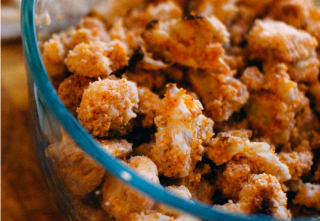 Today’s awesome recipe is from Katie French, author of Paleo Cooking Bootcamp and instructor of our new online course that brings that book to multimedia life.
Today’s awesome recipe is from Katie French, author of Paleo Cooking Bootcamp and instructor of our new online course that brings that book to multimedia life.
Whether you’re looking for a great keto- or Primal-friendly side dish or a game day buffet item, Katie’s recipe is a delicious choice. Check it out and learn a bit more about Katie’s own ancestral diet story. Happy weekend, everyone!
These cauliflower buffalo wings are a tasty way to add extra vegetables to your diet.
Ingredients
1 large or 2 small heads of cauliflower
1 cup (100g) of almond flour
1 teaspoon Himalayan sea salt
1 teaspoon smoked paprika
1 teaspoon garlic powder
1/4 cup (56ml) avocado oil
1 teaspoon hot sauce
Have you met our Paleo Cooking Bootcamp instructor, Katie French? Get to know her paleo story!
And don’t miss out on the limited time offer for her online, multimedia course, Paleo Cooking Bootcamp: A step-by-step meal preparation course that allows you to cook breakfast, lunch, and dinner options for an entire week in a single, highly focused two-hour power cooking session. Four sessions make for a month-long bootcamp.
This innovative online course is inspired by creator Katie French’s live class that she presented in the San Francisco Bay Area, where it won the prestigious “Best of SF” designation by San Francisco Magazine.
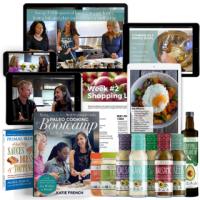 Katie has now brought her intentional cooking method into digital format so you can join her and the featured students in the course—real-life busy moms and career folks trying to up their game in the kitchen—every step of the way.
Katie has now brought her intentional cooking method into digital format so you can join her and the featured students in the course—real-life busy moms and career folks trying to up their game in the kitchen—every step of the way.
Enroll in the Paleo Cooking Bootcamp course and receive a complimentary bottle of Primal Kitchen Extra Virgin Avocado Oil. Just use code NEWCOURSE at checkout. This offer includes free shipping for domestic orders.
The post Game Day Eats: Cauliflower Buffalo Wings appeared first on Mark's Daily Apple.



Mark Sisson's Blog
- Mark Sisson's profile
- 199 followers









